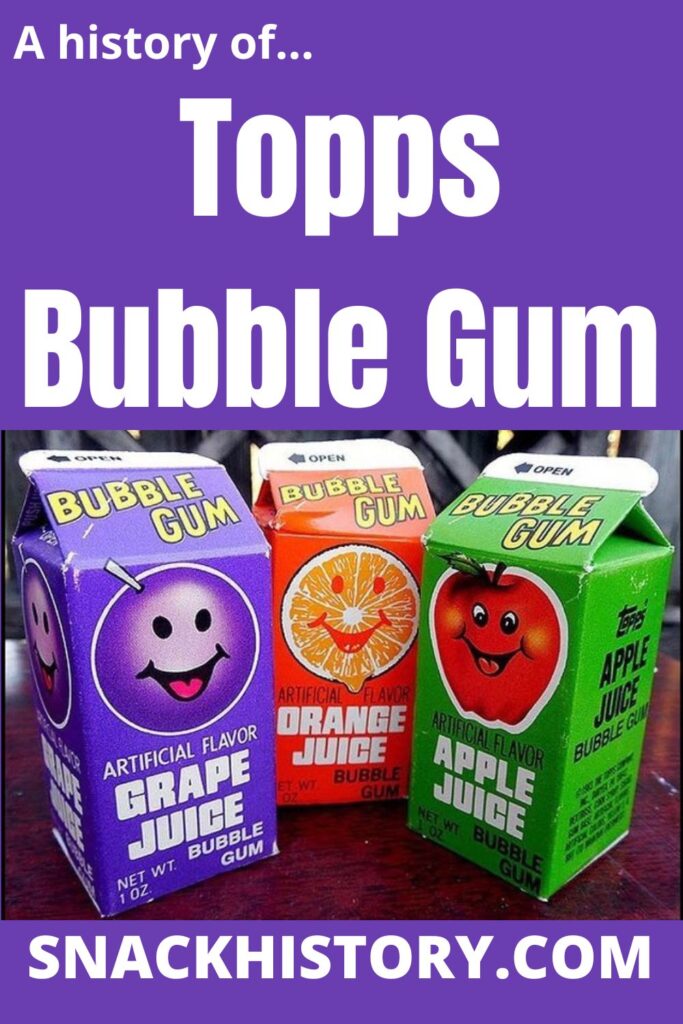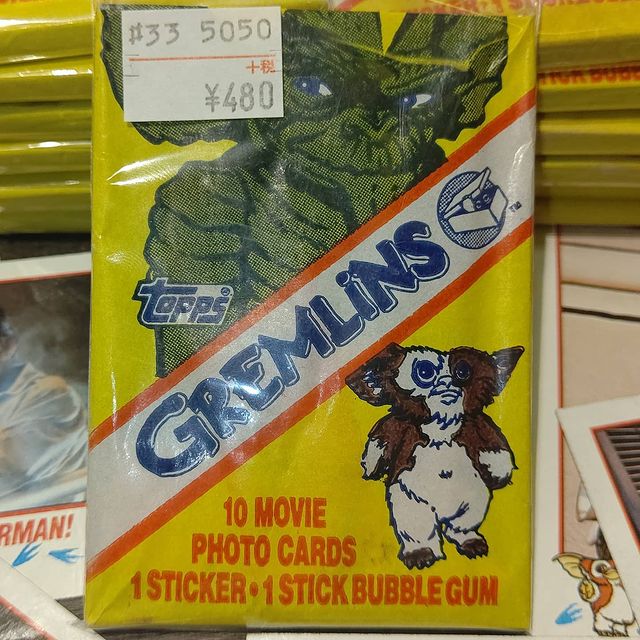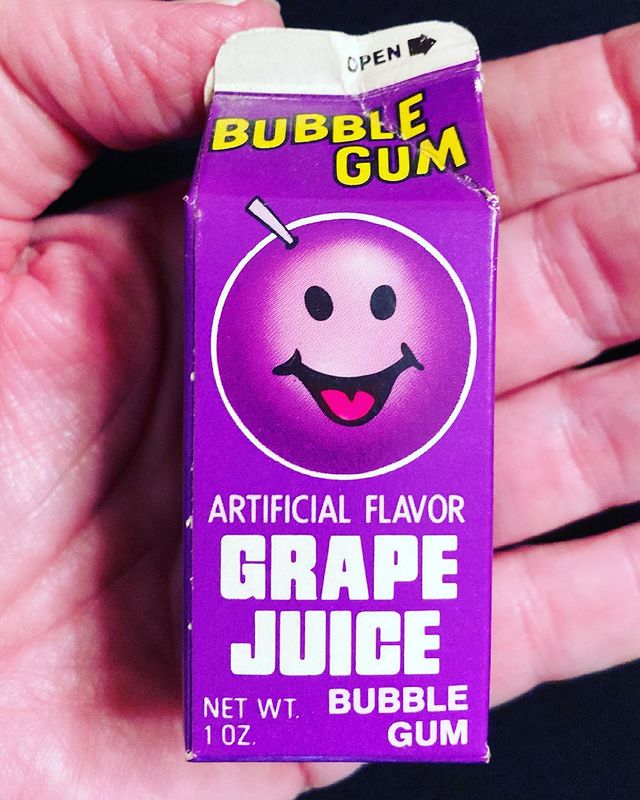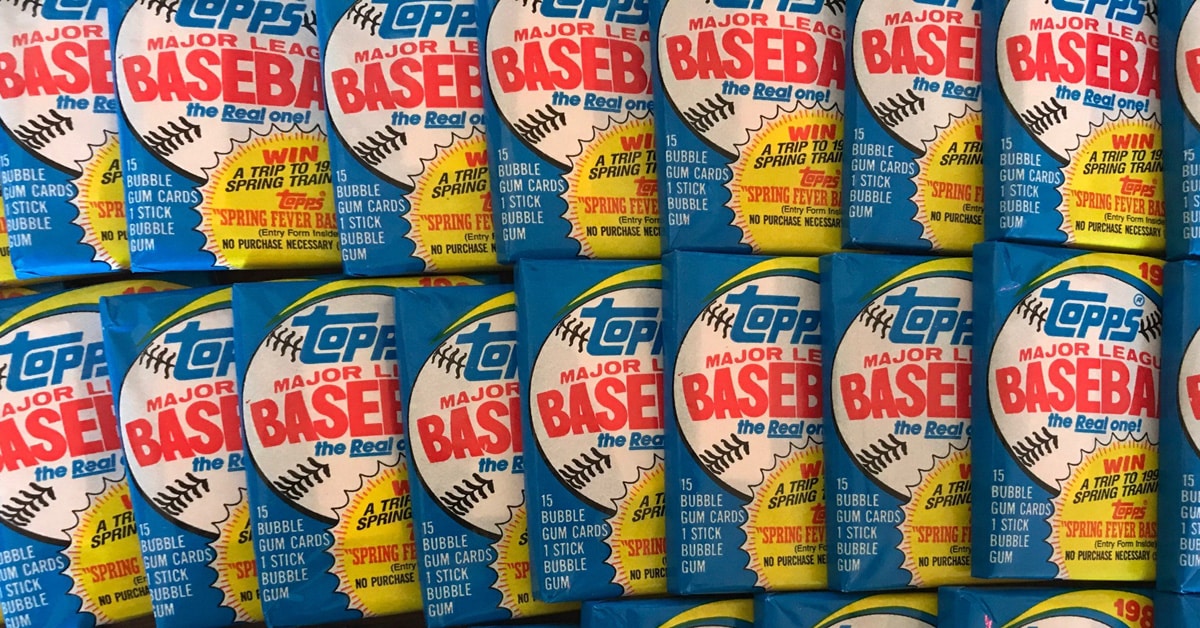Topps Bubble Gum
Topps Bubble Gum was first sold in association with baseball trading cards made by the Topps company. Baseball and chewing gum have a long, rich, and interconnected history that dates back to the first pitchers chewing brands of gum that were sponsors of their team. Sports and gum became linked to one another as soon as this marketing ploy was put in motion, and they have stayed connected to one another ever since.
If you love baseball trading cards and you collected them when you were a kid, there’s a chance that you also bought Topps Gum. Topps is also associated with Bazooka Joe gum products, which were linked with the Bazooka Joe Comics. From the late 40s-the 1970s, it seemed like Topps products were everywhere. Topps Bubble Gum might not be offered in packs of baseball cards anymore, but the company still makes various other gum-based products.
Please leave a review or any memories of this snack in the comments at the bottom of this page. Thank you!

History
The Topps company began life as Topps Chewing Gum Inc. This was a partnership between four brothers. The Shorin brothers built the company into a big success very quickly, and they moved the headquarters of the business to Pennsylvania in 1965 to be able to make enough gum to keep up with demand. As baseball became exponentially more popular in the US, player’s trading cards were items that children and adults alike coveted. This created an opportunity in the eyes of the Shorin brothers, who quickly designed a 52-card deck of playing cards that would allow you to play a baseball game in card form.
The goal of creating these cards was for people to buy multiple packs of gum to try and get all the cards necessary to play the game. The cards could also be traded just like regular players’ trading cards. This idea was such a success that the Topps company created a bigger set of cards in 1952, this time offering 407 cards in total. The size of the cards was increased as well, and the images on the portrait side were made bigger and were of better quality.
The redesigned cards were released as a series over a period of time, which helped to drive interest and keep consumers coming back for more. While the gum products itself was probably a welcome aspect of the purchase, there was no question that the Topps trading cards were the real draw for consumers. Fierce competition with other playing card companies who were also selling gum products led to expensive player’s contract bidding wars and other expensive setbacks for the company. However, Topps felt that it was worth the effort to try and stay ahead of the competition by being able to offer exclusive cards with players who were not represented in other card sets.
Topps also tried to dodge difficulties related to contracts with players by selling players’ cards with other kinds of candy products. There were a series of players’ cards that were sold with caramel products rather than gum products in the 50s in order to be able to sell products associated with top players. One particular company, Bowman Gum, actually sued Topps over exclusivity breaches related to selling these products.
Despite all of this, baseball cards and Topps were names that belonged together to most consumers. Even through the 1970s, Topps playing cards and baseball were synonymous with one another. Consumers could count on high-quality cards in each pack of Topps, and they were willing to ignore brands with better-tasting gum just to be able to collect glossy, full-color cards with unique images of their favorite players on them.
Arthur Shorin took over the company near the end of the 1970s, and his first move was to create a chocolate bubble gum which was supposed to help grow sales. This sounds like a terrible product to anyone who is familiar with gum as a breath freshener, and apparently, contemporary consumers felt the same way. Shorin later admitted that this was a misstep that caused company losses and which certainly did not draw consumers away from other gum and trading card options made by competitors.
To add injury to insult, basketball, and hockey were becoming as popular as baseball with sports lovers. And looming just over the horizon was the specter that would become American football. There is no sport more familiar or popular today in the US than football, meaning that baseball’s popularity was about to end.
As baseball became something that fewer and fewer Americans were interested in, the Shorin family realized that they might have put too many eggs into one basket. The baseball cards that Topps sold exclusively and which had once been valuable and collectible were now associated with a sport that was on the decline. Football was replacing baseball for many consumers, and Topps needed to change its marketing style to keep up with this shift.
Many of the last series of baseball cards that were created to be sold with packs of gum were actually dumped into the Atlantic Ocean rather than being sold. This has created a huge markup on this unique series of cards for today’s collectors since there were relatively few of them sold at the time, and many of the surplus stocks were completely destroyed.
Topps would lose its monopoly on a variety of different kinds of player exclusivity contracts when the US Federal court ruled that Topps did not have exclusive rights to selling baseball-related trading cards anymore. This allowed other companies to move into the space in the early 1980s, proving to be the final nail in the coffin for the Topps gum products. Even Kellogg’s began producing “3-D” cards that were essentially player’s cards once the federal ruling was handed down.
Collectors will tell you that the gum itself was not very good, and many of them didn’t even chew the gum. They were interested in collecting the cards that Topps produced for both football and baseball but much less interested in the gum product itself. This is also likely the reason that the current owners of the product line have not continued to sell the gum products that were formerly associated with trading cards.
The company changed hands a few times, finally being purchased by Michael Eisner. This was when Topps gum products were first linked with entertainment products and the movie industry. Bazooka Joe gum products entered the company lineup at this point, and they have supplanted Topps trading card products for good. If you were not a child in the 70s or 80s, you might not even know that Topps Gum used to sell trading cards or that the company had an exclusive contract to create all the gum-related trading card products in the US.
Changes to how people consume sports events and to the kinds of interests that are associated with sports collecting would probably have eventually led to the demise of the Topps trading card products no matter what. However, it does demonstrate just how pervasive and important baseball was to American culture when you find out that the stranglehold that Topps had on trading card gum sales had to be broken by a federal court decision. Today it’s hard to imagine baseball being the national pastime, but in the days when Topps Chewing Gum Inc was at the peak of its popularity, there was no marketing motivation more powerful to the American consumer.
Livery
Early in the life of the trading card part of the company, the Topps gum products actually usually indicated that the gum inside was Bazooka gum with baseball cards. These ads were hand drawn and stated that the items inside the pack were “Picture Card Bubble Gum”. Bazooka was billed as “The Chew of Champions” on these gum packs. For those who have chewed Bazooka gum today, it is striking just how much the original wrappers for these gum products looked like the current gum.
The Topps Bubble Gum cards that were collected by baseball enthusiasts over the years changed appearance frequently. New series of cards, new deals with new players, and changes to the appearance of the uniforms of players had a big impact on the styling of the Topps gum card products. The Topps logo itself was often some version of a baseball with lettering scrolling across it. The image might be of a real baseball, or it might be a drawing of a baseball. Each pack always declared that it was “The Real One!”
The colors of the cards were often primary colors, with blues and reds being very common. However, in the late 70s and early 80s, the cards were sometimes sold with orange wrappers or even purple and blue wrappers. Images of the cards that were inside the packs showed up on most of the wrappers, and there was often language that indicated that you were to collect all the various cards that were offered in each set.
Logo

Ingredients
- Sugar
- Gum Base
- Corn Syrup
- Glycerin
- Soy Lecithin (Emulsifier)
- Citric Acid
- Triacetin
- Artificial Flavors
- BHT (to Maintain Freshness)
- Artificial Colors (FD&C 40)
- Talc
Nutrition
| Portion Size: | 6g | % Daily Value * |
| Amount Per Portion | ||
| Calories | 20 | |
| Total Fat | 0g | 0% |
| Total Carbohydrate | 5g | 2% |
| Sugar | 4g | |
| Protein | 0g | 0% |
- The % Daily Value (DV) tells you how much a nutrient in a serving of food contributes to a daily diet. 2000 calories a day is used for general nutrition advice.
Pictures


Ads:
An NBC News presentation about Topps Baseball cards and gum:
A Topps ad from 1989:
Jason has been a snack addict since his early years and now enjoys nothing more than reviewing his favourite candys and sweets.
Please leave a review or any memories of this snack in the comments below. Thank you!
Click here for a full A-Z list of Snacks and Candy
